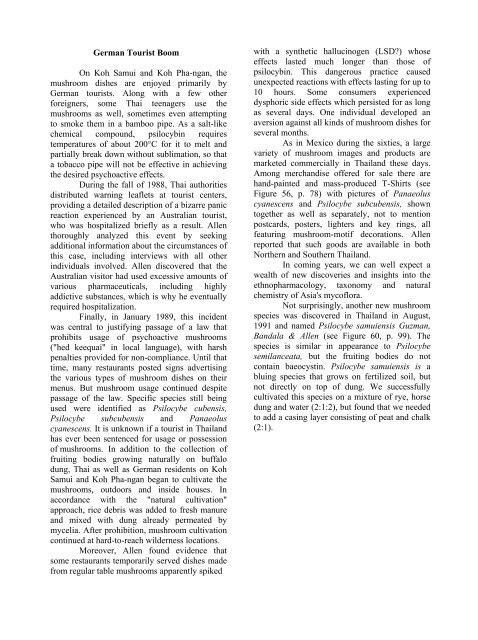Jochen Gartz - Magic Mushrooms Around the ... - preterhuman.net
Jochen Gartz - Magic Mushrooms Around the ... - preterhuman.net
Jochen Gartz - Magic Mushrooms Around the ... - preterhuman.net
Create successful ePaper yourself
Turn your PDF publications into a flip-book with our unique Google optimized e-Paper software.
German Tourist Boom<br />
On Koh Samui and Koh Pha-ngan, <strong>the</strong><br />
mushroom dishes are enjoyed primarily by<br />
German tourists. Along with a few o<strong>the</strong>r<br />
foreigners, some Thai teenagers use <strong>the</strong><br />
mushrooms as well, sometimes even attempting<br />
to smoke <strong>the</strong>m in a bamboo pipe. As a salt-like<br />
chemical compound, psilocybin requires<br />
temperatures of about 200°C for it to melt and<br />
partially break down without sublimation, so that<br />
a tobacco pipe will not be effective in achieving<br />
<strong>the</strong> desired psychoactive effects.<br />
During <strong>the</strong> fall of 1988, Thai authorities<br />
distributed warning leaflets at tourist centers,<br />
providing a detailed description of a bizarre panic<br />
reaction experienced by an Australian tourist,<br />
who was hospitalized briefly as a result. Allen<br />
thoroughly analyzed this event by seeking<br />
additional information about <strong>the</strong> circumstances of<br />
this case, including interviews with all o<strong>the</strong>r<br />
individuals involved. Allen discovered that <strong>the</strong><br />
Australian visitor had used excessive amounts of<br />
various pharmaceuticals, including highly<br />
addictive substances, which is why he eventually<br />
required hospitalization.<br />
Finally, in January 1989, this incident<br />
was central to justifying passage of a law that<br />
prohibits usage of psychoactive mushrooms<br />
("hed keequai" in local language), with harsh<br />
penalties provided for non-compliance. Until that<br />
time, many restaurants posted signs advertising<br />
<strong>the</strong> various types of mushroom dishes on <strong>the</strong>ir<br />
menus. But mushroom usage continued despite<br />
passage of <strong>the</strong> law. Specific species still being<br />
used were identified as Psilocybe cubensis,<br />
Psilocybe subcubensis and Panaeolus<br />
cyanescens. It is unknown if a tourist in Thailand<br />
has ever been sentenced for usage or possession<br />
of mushrooms. In addition to <strong>the</strong> collection of<br />
fruiting bodies growing naturally on buffalo<br />
dung, Thai as well as German residents on Koh<br />
Samui and Koh Pha-ngan began to cultivate <strong>the</strong><br />
mushrooms, outdoors and inside houses. In<br />
accordance with <strong>the</strong> "natural cultivation"<br />
approach, rice debris was added to fresh manure<br />
and mixed with dung already permeated by<br />
mycelia. After prohibition, mushroom cultivation<br />
continued at hard-to-reach wilderness locations.<br />
Moreover, Allen found evidence that<br />
some restaurants temporarily served dishes made<br />
from regular table mushrooms apparently spiked<br />
with a syn<strong>the</strong>tic hallucinogen (LSD) whose<br />
effects lasted much longer than those of<br />
psilocybin. This dangerous practice caused<br />
unexpected reactions with effects lasting for up to<br />
10 hours. Some consumers experienced<br />
dysphoric side effects which persisted for as long<br />
as several days. One individual developed an<br />
aversion against all kinds of mushroom dishes for<br />
several months.<br />
As in Mexico during <strong>the</strong> sixties, a large<br />
variety of mushroom images and products are<br />
marketed commercially in Thailand <strong>the</strong>se days.<br />
Among merchandise offered for sale <strong>the</strong>re are<br />
hand-painted and mass-produced T-Shirts (see<br />
Figure 56, p. 78) with pictures of Panaeolus<br />
cyanescens and Psilocybe subcubensis, shown<br />
toge<strong>the</strong>r as well as separately, not to mention<br />
postcards, posters, lighters and key rings, all<br />
featuring mushroom-motif decorations. Allen<br />
reported that such goods are available in both<br />
Nor<strong>the</strong>rn and Sou<strong>the</strong>rn Thailand.<br />
In coming years, we can well expect a<br />
wealth of new discoveries and insights into <strong>the</strong><br />
ethnopharmacology, taxonomy and natural<br />
chemistry of Asia's mycoflora.<br />
Not surprisingly, ano<strong>the</strong>r new mushroom<br />
species was discovered in Thailand in August,<br />
1991 and named Psilocybe samuiensis Guzman,<br />
Bandala & Allen (see Figure 60, p. 99). The<br />
species is similar in appearance to Psilocybe<br />
semilanceata, but <strong>the</strong> fruiting bodies do not<br />
contain baeocystin. Psilocybe samuiensis is a<br />
bluing species that grows on fertilized soil, but<br />
not directly on top of dung. We successfully<br />
cultivated this species on a mixture of rye, horse<br />
dung and water (2:1:2), but found that we needed<br />
to add a casing layer consisting of peat and chalk<br />
(2:1).








![The Big Lie 9-11 and Government Complicity in Mass Murder [PDF]](https://img.yumpu.com/50957077/1/190x245/the-big-lie-9-11-and-government-complicity-in-mass-murder-pdf.jpg?quality=85)








